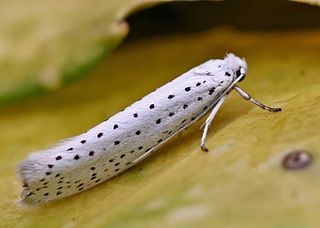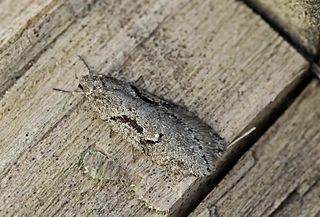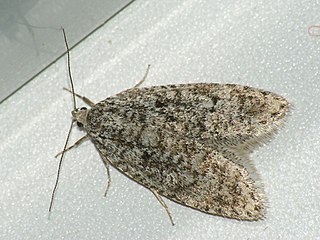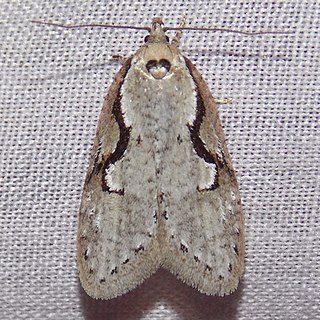
Lepidoptera is an order of insects that includes butterflies and moths. About 180,000 species of the Lepidoptera are described, in 126 families and 46 superfamilies, 10 percent of the total described species of living organisms. It is one of the most widespread and widely recognizable insect orders in the world. The Lepidoptera show many variations of the basic body structure that have evolved to gain advantages in lifestyle and distribution. Recent estimates suggest the order may have more species than earlier thought, and is among the four most species-rich orders, along with the Hymenoptera, Diptera, and Coleoptera.

The family Yponomeutidae are known as the ermine moths, with several hundred species, most of them in the tropics. The larvae tend to form communal webs, and some are minor pests in agriculture, forestry, and horticulture. Adult moths are minor pollinators.

Arthur Gardiner Butler F.L.S., F.Z.S. was an English entomologist, arachnologist and ornithologist. He worked at the British Museum on the taxonomy of birds, insects, and spiders.

Schinia, commonly called flower moths, is a large genus of moths belonging to the family Noctuidae. The genus has a Holarctic distribution with the vast majority of species being found in North America, many with a very restricted range and larval food plant.
Agathiphaga is a genus of moths, known as kauri moths. It is the only living in the family Agathiphagidae. This caddisfly-like lineage of primitive moths was first reported by Lionel Jack Dumbleton in 1952, as a new genus of Micropterigidae.

The Thyatirinae, or false owlet moths, are a subfamily of the moth family Drepanidae with about 200 species described. Until recently, most classifications treated this group as a separate family called Thyatiridae.

The Depressariinae – sometimes spelled "Depressiinae" in error – are a subfamily of moths in the superfamily Gelechioidea. Like their relatives therein, their exact relationships are not yet very well resolved. It has been considered part of family Elachistidae sensu lato or included in an expanded Oecophoridae. In modern classifications they are treated as the distinct gelechioid family Depressariidae.

The Erebinae are a subfamily of moths in the family Erebidae erected by William Elford Leach in 1815. Erebine moths are found on all continents except Antarctica, but reach their greatest diversity in the tropics. While the exact number of species belonging to the Erebinae is not known, the subfamily is estimated to include around 10,000 species. Some well-known Erebinae include underwing moths (Catocala) and witch moths (Thermesiini). Many of the species in the subfamily have medium to large wingspans, up to nearly 30 cm in the white witch moth, which has the widest wingspan of all Lepidoptera. Erebine caterpillars feed on a broad range of plants; many species feed on grasses and legumes, and a few are pests of castor bean, sugarcane, rice, as well as pistachios and blackberries.

Semioscopis steinkellneriana is a species of moth of the family Depressariidae. It is found from most of Europe east to the eastern parts of the Palearctic realm.

Semioscopis is a moth genus of the superfamily Gelechioidea. It is placed in the subfamily Depressariinae.

Semioscopis avellanella is a species of moth of the family Depressariidae. It is found in most of Europe east to the eastern parts of the Palearctic realm.

Semioscopis oculella is a species of moth of the family Depressariidae. It is found in most of Europe east to the eastern parts of the Palearctic realm.

Semioscopis strigulana is a species of moth of the family Depressariidae. It is found in most of Europe east to the eastern parts of the Palearctic realm.
Semioscopis aurorella, the aurora flatbody moth, is a species of moth of the family Depressariidae. It was described by Harrison Gray Dyar Jr. in 1902. It is found in Canada from north-central Alberta to south-eastern Ontario, south into the United States between south-central New York and Wisconsin.

Semioscopis inornata, the dull flatbody moth, is a species of moth of the family Depressariidae. It was described by Walsingham in 1882. It is found throughout Canada and northern United States.
Semioscopis mcdunnoughi is a species of moth of the family Depressariidae. It was described by John Frederick Gates Clarke in 1941. It is found in western North America, including Washington and British Columbia.

Semioscopis packardella, also called Packard's concealer moth or Packard's flatbody moth, is a species of moth of the family Depressariidae. It was described by James Brackenridge Clemens in 1863. It is found in North America in central Alberta, southern Quebec, Manitoba, California, Idaho and Oregon and from New Jersey to Ohio.
Semioscopis japonicella is a moth in the family Depressariidae. It was described by Sato in 1989. It is found in Japan.
Semioscopis osthelderi is a moth in the family Depressariidae. It was described by Rebel in 1936. It is found in Syria.
Semioscopis similis is a moth in the family Depressariidae. It was described by Sato in 1989. It is found in Japan.












